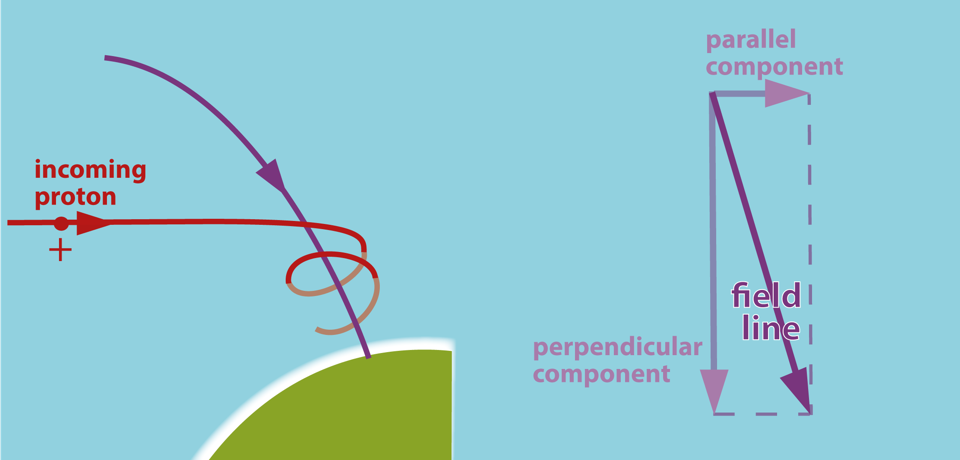Connecting pre-university students with professional science

Contextual Curriculum Connections
Antarctic A11 Effect of magnetic field on moving charged particles
in the context of the southern aurora
A presentation on the effects of solar storms, with a focus on North America, from the United States Geological Survey, USGS
Guanren Wang, a researcher at the British Geological Survey, provides a brief introduction to his work on geomagnetism.

The solar wind is a stream of particles, mostly protons and electrons, streaming away from the Sun’s violent activity. Earth’s magnetic field deflects most of the particles, protecting us from the harm they can do by ionising material, including the material of our bodies.
During times of especially high solar activity, energetic particles can get closer to the planet. This diagram shows a field line near the North Pole, and an incoming proton. The field has components parallel and perpendicular to the proton motion.
The left hand motor rule tells us that the parallel component has no effect on the proton, but the perpendicular component produces a force that adds a helical effect to the proton’s existing motion, and adding to its already high speed.
An introduction to the work of the Indian Institute of Geomagnetism, IIG
A representation of the Earth and its magnetic field.

Awkward Physics … is the Earth upside down?*
If you look at a bar magnet, the red end is normally the ’north’ pole. (This is short for north-seeking pole, geographically speaking.)
But we know that ‘like poles repel’. So if we are going to stick to the idea that the red end is the north then we have to make a BIG confession. The Earth’s geographic North Pole is a … erm … a … a magnetic South Pole.
Magnetic field lines at one place around a magnet point show the directions of the force that would be experienced by an imagined small isolated North Pole. So this image is correct in showing that the field lines are pointed towards the geographic North Pole, AKA the Earth’s magnetic South Pole.
* In the wider environment (aka ‘space’) the words up, down, and upside down, are meaningless.
Field strengths:
Gravitational field strength = g = F/m (F is force, m is mass)
Electric field strength = E = F/q (F is force, q is charge)
Spot the pattern? Field strength is the ratio of force to the feature that a body must possess (mass or charge) in order to be subject to the force.
What property must a body have to experience in order to experience magnetic force? Charge, q, and velocity perpendicular to the field, v.
Magnetic field strength = B = F/qv
Note, however, that B is often called magnetic flux density. Lines of force are closer together where the field is stronger.
(F is force, q is charge and v is velocity perpendicular to the field)
(C) David Brodie 2025 Note that all external videos and websites remain copyright of the creators
